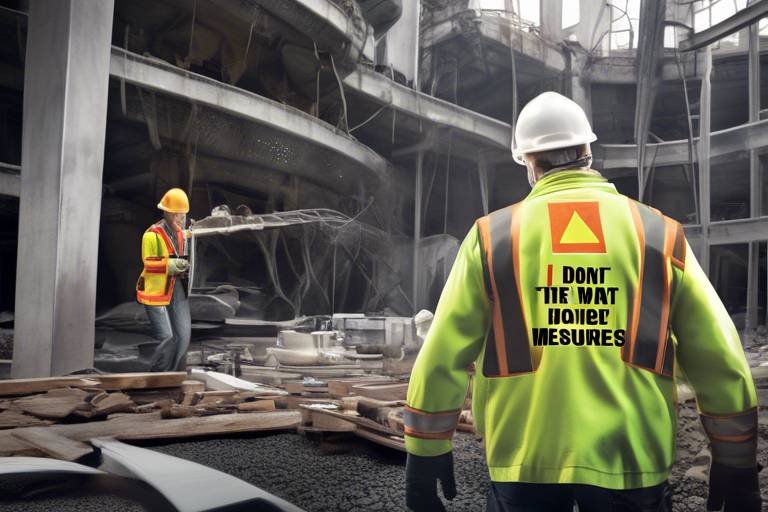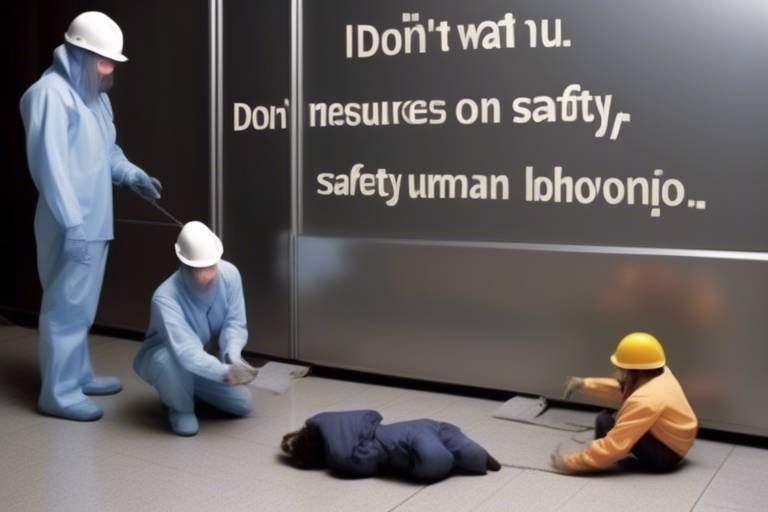Emphasizing the Relevance of Human Behavior in Safety Measures
In today's fast-paced world, the importance of safety measures cannot be overstated. However, what often gets overlooked is the **critical role** that human behavior plays in the effectiveness of these measures. It’s not just about having rules and regulations in place; it’s about how individuals perceive, understand, and respond to these safety protocols. Imagine a well-constructed safety policy as a beautiful house. Without the right occupants who respect and maintain it, that house can quickly fall into disrepair. This analogy highlights the essence of human behavior in safety practices.
When we discuss safety, we must consider various **psychological factors** that influence how people act in potentially hazardous situations. For instance, motivation can drive an employee to adhere to safety protocols, while a lack of understanding can lead to negligence. Moreover, the way individuals perceive risks can significantly impact their decision-making processes. If someone does not see a particular hazard as dangerous, they are less likely to take the necessary precautions. This perception is shaped by **experience, training, and organizational culture**, all of which play a crucial role in establishing a safe working environment.
Furthermore, the behavior of individuals is often a reflection of the **training they receive**. Effective training is not merely about imparting knowledge; it’s about instilling a sense of responsibility and awareness regarding safety practices. When employees are engaged and understand the 'why' behind safety measures, they are more likely to comply. Think of training as planting seeds in a garden. If nurtured properly, those seeds will grow into a robust system of safety practices that thrive on accountability and shared responsibility.
In this article, we will explore the psychological aspects of safety behavior, the importance of training, and the influence of organizational culture and leadership on safety practices. By understanding these components, we can enhance safety measures and ultimately create a safer environment for everyone involved. After all, safety is not just a set of rules; it’s a **collective responsibility** that relies heavily on the behavior and attitudes of individuals.
Understanding the psychological aspects that drive human behavior can significantly enhance safety measures. This section delves into motivation, perception, and decision-making processes that affect how individuals respond to safety protocols.
Effective training programs are essential in promoting safety compliance. This subheading discusses various training methodologies and their impact on improving employees' understanding and adherence to safety measures.
Behavioral-based safety training focuses on modifying employee behavior to enhance safety practices. This approach emphasizes observation, feedback, and reinforcement to create a safer work environment.
Incorporating feedback mechanisms in training can significantly improve safety behaviors. This section explores how constructive feedback helps reinforce positive behaviors and correct unsafe practices.
Engagement strategies are vital in ensuring that safety training is effective. This part discusses interactive training methods that keep employees involved and motivated to learn safety protocols.
An organization’s culture profoundly influences safety behaviors. This section examines how a positive safety culture promotes accountability, communication, and shared responsibility among employees.
Leadership plays a pivotal role in shaping safety behaviors within organizations. This subheading highlights how leaders can foster a culture of safety through their actions and communication.
Leaders who model safe behaviors set a standard for their teams. This section discusses the importance of leaders demonstrating commitment to safety practices and how it impacts employee behavior.
Open communication is essential for effective safety measures. This part explores how fostering an environment where employees feel comfortable reporting hazards can enhance overall safety.
- What is the importance of human behavior in safety measures?
Human behavior is crucial as it determines how effectively safety measures are implemented and followed. Understanding psychological factors can lead to better compliance. - How can training improve safety compliance?
Effective training enhances understanding and motivates employees to adhere to safety protocols, thus reducing the likelihood of accidents. - What role does leadership play in promoting safety?
Leadership sets the tone for safety culture. Leaders who demonstrate commitment to safety inspire their teams to prioritize safe practices.

The Psychology of Safety Behavior
Understanding the psychological aspects that drive human behavior is crucial for enhancing safety measures in any environment. It's fascinating how our minds work when it comes to risk assessment and decision-making. People often underestimate hazards, thinking, “It won’t happen to me,” which can lead to unsafe practices. This mindset is influenced by various factors, including motivation, perception, and the context in which decisions are made. For instance, when employees perceive safety protocols as unnecessary or overly complicated, they may become disengaged, resulting in non-compliance.
Motivation plays a significant role in how individuals respond to safety measures. When employees feel that their safety is prioritized and that they are valued, they are more likely to adhere to safety protocols. This can be enhanced through positive reinforcement and recognition programs that reward safe behavior. On the flip side, fear-based approaches often lead to resistance and a culture of blame, which can stifle open communication about safety concerns.
Furthermore, our perception of risk can be skewed by personal experiences and societal influences. For example, if someone has never witnessed an accident, they might perceive their environment as entirely safe, leading to complacency. This is where training and education come into play. By providing employees with real-life scenarios and data on safety incidents, organizations can help shift their perception, making them more aware of potential risks.
Decision-making processes are also pivotal in the realm of safety behavior. When faced with a choice between taking a shortcut or following safety protocols, the decision often hinges on how individuals weigh the perceived benefits against potential risks. Emphasizing the importance of safety through regular discussions and training can help employees make better choices. By creating a culture that prioritizes safety, organizations can foster an environment where safe behaviors become second nature.
In summary, the psychology of safety behavior encompasses a range of factors that influence how individuals perceive and respond to safety measures. By understanding these psychological elements, organizations can develop more effective safety programs that not only comply with regulations but also resonate with employees on a personal level. This leads to a more engaged workforce and, ultimately, a safer workplace.
- What is the importance of understanding psychology in safety measures?
Understanding psychology helps organizations tailor their safety programs to address human behavior, enhancing compliance and reducing accidents.
- How can motivation affect safety behavior?
When employees feel motivated and valued, they are more likely to adhere to safety protocols, leading to a safer work environment.
- What role does perception play in safety compliance?
Perception influences how individuals assess risks, which can lead to either adherence to safety measures or complacency.

The Role of Training in Safety Compliance
Effective training programs are the backbone of any organization’s safety compliance strategy. They not only equip employees with the necessary knowledge but also instill a sense of responsibility towards maintaining a safe work environment. Imagine a ship without a captain; it would drift aimlessly, much like a workplace without proper safety training. The key is to ensure that training is not just a one-time event but an ongoing process that evolves with the organization’s needs.
One of the most impactful aspects of safety training is its ability to change behavior. When employees understand the importance of safety protocols and the potential consequences of neglecting them, they are more likely to adhere to established guidelines. This is where behavioral-based safety training comes into play. By focusing on modifying employee behavior through observation, feedback, and reinforcement, organizations can create a safer work environment. For instance, if an employee consistently follows safety protocols, positive reinforcement can encourage this behavior, fostering a culture of safety.
Moreover, the effectiveness of training is significantly enhanced when it incorporates feedback mechanisms. Constructive feedback helps employees recognize their strengths and areas for improvement. It’s like having a coach who not only cheers you on but also points out how you can improve your game. In safety training, this means that employees receive immediate feedback on their performance, allowing them to adjust their behaviors accordingly. This two-way communication can be instrumental in reinforcing positive actions and correcting unsafe practices.
Engagement strategies also play a crucial role in ensuring that safety training resonates with employees. Traditional training methods, such as lectures, can often lead to disengagement. Instead, organizations should consider incorporating interactive training methods, such as simulations and role-playing. These approaches not only make learning more enjoyable but also help employees relate to real-life scenarios they may encounter on the job. For example, a fire drill simulation can effectively prepare employees for an actual emergency, making the training memorable and impactful.
It is essential to remember that the training should be tailored to meet the unique needs of the organization and its employees. This customization ensures that the training is relevant and applicable, which in turn enhances compliance. By understanding the specific hazards of their work environment, employees can better appreciate the importance of safety measures. This tailored approach can be illustrated in the table below:
| Training Method | Advantages | Best Suited For |
|---|---|---|
| Behavioral-Based Training | Focuses on modifying behavior through feedback | High-risk environments |
| Interactive Training | Engages employees and enhances retention | All work environments |
| Tailored Training Programs | Addresses specific hazards and needs | Industries with unique risks |
In conclusion, the role of training in safety compliance cannot be overstated. It is not merely about checking off a box on a list of requirements; it is about fostering a culture of safety that permeates every level of the organization. By investing in comprehensive training programs that prioritize engagement, feedback, and customization, organizations can significantly enhance their safety compliance and, ultimately, protect their most valuable asset: their employees.
- What is the importance of safety training? Safety training is crucial as it equips employees with the knowledge and skills to recognize hazards and respond appropriately, thereby reducing the risk of accidents.
- How often should safety training be conducted? Safety training should be an ongoing process, with regular refreshers and updates provided to ensure employees stay informed about any changes in protocols or regulations.
- What are some effective training methods? Effective training methods include behavioral-based training, interactive simulations, and tailored programs that address specific workplace hazards.

Behavioral-Based Safety Training
Behavioral-Based Safety Training (BBST) is a dynamic approach that focuses on understanding and modifying the behaviors of employees to enhance safety practices within the workplace. Imagine a scenario where every employee is not just aware of safety protocols but is actively engaged in practicing them daily. This is the essence of BBST—it’s about creating a culture where safety becomes second nature, much like how we instinctively buckle our seatbelts when getting into a car.
The foundation of BBST lies in the idea that most workplace incidents are a result of unsafe behaviors rather than unsafe conditions. By observing these behaviors, providing feedback, and reinforcing positive actions, organizations can significantly reduce accidents and injuries. This method emphasizes observation and feedback as critical components. For instance, safety leaders might conduct regular observations of work practices, followed by constructive feedback sessions. This not only helps in identifying unsafe behaviors but also encourages employees to adopt safer practices.
One of the key elements of BBST is the use of reinforcement strategies. When employees exhibit safe behaviors, recognizing and rewarding them can create a positive feedback loop. Think of it as training a dog; when it performs a trick correctly, it gets a treat. Similarly, when employees follow safety protocols, they should receive acknowledgment, which can motivate them to continue those behaviors. This reinforcement can take various forms, such as verbal praise, safety awards, or even simple recognition in team meetings.
Additionally, BBST encourages participation from all levels of the organization. Employees are not merely passive recipients of safety information; they are active participants in shaping safety practices. This engagement can be fostered through open discussions about safety challenges, brainstorming solutions, and sharing personal experiences related to safety. When employees feel their voices are heard and their contributions matter, they are more likely to take ownership of their safety responsibilities.
To illustrate the effectiveness of BBST, consider a manufacturing company that implemented this training program. Initially, they faced a high rate of workplace accidents. After introducing BBST, the company observed a significant decline in incidents over a six-month period. Employees reported feeling more empowered and aware of their safety practices, leading to a safer working environment. This transformation highlights the potential of BBST to not only change behaviors but to cultivate a culture of safety that permeates every aspect of the organization.
In conclusion, Behavioral-Based Safety Training is more than just a training program; it’s a comprehensive approach to fostering a safe work environment. By focusing on behavior modification through observation, feedback, and engagement, organizations can significantly enhance their safety measures. It's about creating a workplace where safety is a shared responsibility, and everyone plays a role in maintaining a safe environment.

Feedback Mechanisms in Training
Incorporating feedback mechanisms in safety training is not just a box to check; it's a vital component that can dramatically enhance safety behaviors among employees. Think of feedback as the fuel that keeps the engine of safety running smoothly. Without it, the vehicle of compliance can sputter and stall. When employees receive timely and constructive feedback, they are more likely to understand the importance of safety protocols and how their actions impact the overall safety culture.
Feedback should be specific, actionable, and timely. For instance, instead of saying, "You need to work on your safety practices," a more effective feedback approach would be, "I noticed you were not wearing your safety goggles while operating the machinery. It’s crucial to wear them to protect your eyes from potential hazards." This kind of feedback not only identifies the issue but also provides a clear guideline on what needs to be changed.
Moreover, feedback should not be a one-way street. Engaging employees in a dialogue about safety can foster a culture of openness and continuous improvement. Employees should feel empowered to share their experiences and suggestions regarding safety measures. This two-way communication can lead to a richer understanding of the challenges employees face and how training can be adjusted to meet those needs. For example, if several employees express difficulty in understanding a particular safety protocol, it may indicate a need for further clarification or a different training approach.
Additionally, utilizing various feedback tools can enhance the effectiveness of training programs. Here are some popular methods:
- Surveys and Questionnaires: These can be distributed after training sessions to gauge understanding and gather suggestions for improvement.
- One-on-One Meetings: Personal discussions can help address individual concerns and reinforce the importance of safety behaviors.
- Peer Reviews: Encouraging employees to observe and provide feedback to each other can create a supportive learning environment.
To sum it up, feedback mechanisms are essential in ensuring that safety training is not just a formality but a dynamic process that evolves with the needs of the workforce. By creating a culture where feedback is valued and acted upon, organizations can significantly improve their safety practices and reduce incidents. Remember, safety is a shared responsibility, and feedback is the bridge that connects individual actions to organizational safety goals.
- What is the importance of feedback in safety training?
Feedback helps identify areas for improvement, reinforces positive behaviors, and fosters a culture of open communication. - How can feedback be effectively communicated?
Feedback should be specific, timely, and actionable, allowing employees to understand exactly what needs to change. - What are some effective feedback mechanisms?
Surveys, one-on-one meetings, and peer reviews are some of the effective methods to gather and provide feedback.

Engagement Strategies for Training
When it comes to safety training, keeping employees engaged is not just a bonus—it's a necessity. Think of it this way: would you rather sit through a dull lecture or participate in an interactive workshop where you can share your thoughts and experiences? The latter not only makes learning enjoyable but also enhances retention of crucial safety protocols. Engaging training strategies can transform a mundane session into a dynamic learning experience, ensuring that employees are not just passive recipients of information but active participants in their own safety.
One effective way to boost engagement is through interactive simulations. These simulations mimic real-life scenarios that employees might encounter in their daily operations. By immersing employees in realistic situations, they can practice their responses to potential hazards in a safe environment. For example, a simulation of a fire evacuation can help employees understand the best routes to take and the importance of staying calm under pressure. This hands-on approach not only reinforces learning but also builds confidence in their ability to handle emergencies.
Additionally, incorporating group discussions and team-building exercises can foster a collaborative atmosphere. When employees share their experiences and insights, it creates a sense of community and shared responsibility for safety. This can be particularly effective in diverse teams where different perspectives can lead to innovative solutions for safety challenges. By encouraging open dialogue, organizations can also identify potential safety concerns that may not have been previously addressed.
Another strategy involves utilizing technology to enhance engagement. E-learning platforms and mobile applications can provide flexible training options that cater to various learning styles. For instance, gamifying safety training through quizzes or challenges can motivate employees to participate actively. By rewarding achievements with badges or certificates, organizations can create a sense of accomplishment that drives further engagement.
Moreover, it's essential to incorporate real-world examples into training materials. Sharing stories of actual incidents, both successful and otherwise, can resonate with employees on a personal level. When they see the real consequences of unsafe behavior or the positive outcomes of adhering to safety protocols, it can ignite a sense of urgency and responsibility. This narrative approach can make the training more relatable and impactful.
Lastly, feedback is a crucial component of engagement. During training sessions, providing opportunities for employees to give feedback on the training methods and content can help tailor future programs to better meet their needs. This not only shows that the organization values their input but also fosters a culture of continuous improvement. When employees feel their voices matter, they are more likely to invest themselves in the training process.
In conclusion, engaging employees in safety training is all about creating an interactive, relatable, and responsive learning environment. By implementing these strategies, organizations can enhance the effectiveness of their training programs, ultimately leading to a safer workplace. After all, safety is not just a set of rules; it's a shared commitment that requires active participation from everyone involved.
- What are the benefits of interactive training methods?
Interactive methods increase retention and understanding of safety protocols, making employees more prepared to act in real situations. - How can technology enhance safety training?
Technology can provide flexible learning options and gamified experiences that motivate employees to engage with safety content. - Why is feedback important in training programs?
Feedback helps organizations improve training effectiveness and shows employees that their opinions are valued, fostering a culture of continuous improvement.

Organizational Culture and Safety
When we talk about organizational culture, we're diving into the very fabric of how a workplace operates. It’s not just about the policies and procedures; it's about the shared values, beliefs, and behaviors that shape how employees interact with one another and approach their work. In the context of safety, a strong safety culture is paramount. Imagine a workplace where safety is as ingrained in the daily routine as clocking in and out. In such an environment, employees are not just following rules; they are actively engaged in creating a safe workspace.
The essence of a positive safety culture lies in its ability to promote accountability and communication. When employees feel a shared responsibility for safety, they are more likely to speak up about potential hazards, participate in safety training, and support one another in adhering to safety protocols. This collective mindset can be likened to a well-oiled machine; each part must work in harmony to ensure smooth operation. If one cog falters, the entire system can be compromised.
Moreover, organizations that prioritize safety culture often see enhanced performance and morale. Employees who feel safe and valued are more productive and less likely to experience burnout or accidents. They are motivated not only by the desire to comply with safety regulations but also by a genuine concern for their colleagues. This camaraderie fosters a sense of belonging and loyalty, which is a win-win for both the employees and the organization.
To illustrate the impact of organizational culture on safety, consider the following table that outlines key elements of a robust safety culture:
| Key Element | Description |
|---|---|
| Leadership Commitment | Leaders actively demonstrate their commitment to safety through actions and policies. |
| Employee Involvement | Encouraging employees to participate in safety discussions and decision-making processes. |
| Open Communication | Creating an environment where employees can report hazards without fear of reprisal. |
| Continuous Improvement | Regularly assessing and improving safety practices based on feedback and incidents. |
In summary, fostering a strong organizational culture that emphasizes safety is not just beneficial; it's essential. When safety becomes a core value rather than a checkbox, organizations can create environments where employees feel empowered and responsible for their own safety and that of their peers. It’s about transforming mindsets, encouraging proactive behavior, and ultimately, reducing accidents and injuries in the workplace.
- What is organizational culture? Organizational culture refers to the shared values, beliefs, and practices that shape how members of an organization interact and work together.
- How does culture influence safety? A positive safety culture encourages employees to prioritize safety, communicate openly about hazards, and take responsibility for their own and their colleagues' safety.
- What are some ways to improve safety culture? Leadership commitment, employee involvement, open communication, and continuous improvement are key strategies for enhancing safety culture.

Influence of Leadership on Safety Behavior
Leadership is not just about making decisions and delegating tasks; it’s about shaping the culture of an organization, especially when it comes to safety. The way leaders behave can significantly influence how employees perceive and adhere to safety protocols. When leaders prioritize safety, it sends a clear message that safety is not just a checkbox to tick off but a core value of the organization. Employees are more likely to follow suit when they see their leaders actively engaging in safe practices.
One of the most effective ways leaders can influence safety behavior is by leading by example. When leaders consistently demonstrate safe behaviors, they create a standard for their teams. This is akin to a parent teaching their child to look both ways before crossing the street; if the parent does it, the child is more likely to follow. For instance, if a manager wears personal protective equipment (PPE) and follows safety protocols diligently, employees are likely to mirror that behavior. The message is clear: safety is important, and it starts at the top.
Moreover, creating open communication channels is essential for fostering a culture of safety. Leaders should encourage employees to voice their concerns about safety without fear of retribution. When employees feel comfortable reporting hazards or unsafe conditions, it creates a proactive safety environment. This can be likened to a team of explorers; if one member spots a potential danger, the entire group benefits from that awareness. Leaders can facilitate this by regularly holding safety meetings and encouraging feedback on safety practices.
To illustrate the impact of leadership on safety behavior, consider the following table that outlines key leadership actions and their potential effects on safety culture:
| Leadership Action | Potential Effect on Safety Culture |
|---|---|
| Modeling Safe Behaviors | Increases adherence to safety protocols among employees |
| Encouraging Open Communication | Fosters a proactive approach to identifying and addressing hazards |
| Providing Regular Feedback | Reinforces positive safety behaviors and corrects unsafe practices |
| Recognizing Safe Practices | Motivates employees to prioritize safety in their daily tasks |
Furthermore, leaders should actively participate in safety training sessions. This not only demonstrates their commitment but also allows them to engage directly with employees, addressing their concerns and questions. It’s like a coach training their team; the more involved the coach is, the better the team performs. When leaders are present and engaged, it instills a sense of importance around safety training, making it more likely that employees will take it seriously.
In conclusion, the influence of leadership on safety behavior cannot be overstated. Leaders who prioritize safety, model safe behaviors, and foster open communication create an environment where safety is ingrained in the organizational culture. This, in turn, leads to a more responsible and safety-conscious workforce. As the saying goes, “A chain is only as strong as its weakest link.” In the context of safety, strong leadership ensures that all links are fortified, leading to a safer workplace for everyone.
- How can leaders effectively communicate the importance of safety?
Leaders can hold regular safety meetings, utilize visual aids, and share real-life examples to highlight the importance of safety in the workplace. - What role does employee feedback play in safety practices?
Employee feedback is crucial as it helps identify potential hazards and areas for improvement, fostering a culture of continuous safety enhancement. - Can safety training impact employee morale?
Yes, effective safety training can boost employee morale by making them feel valued and cared for, as it shows the organization prioritizes their well-being.

Leading by Example
When it comes to safety in the workplace, the phrase "leading by example" isn't just a catchy slogan; it's a fundamental principle that can dramatically shift the culture of an organization. Imagine a ship navigating through treacherous waters. If the captain is calm, collected, and demonstrates safe practices, the crew is more likely to follow suit. Similarly, when leaders prioritize safety and embody the behaviors they wish to see in their teams, they set a powerful precedent that resonates throughout the organization.
One of the most compelling aspects of leading by example is the impact it has on employee morale. When employees see their leaders actively participating in safety protocols—whether it’s wearing personal protective equipment (PPE), conducting safety checks, or engaging in training sessions—they feel a sense of shared responsibility. This engagement fosters a culture where safety is not just a checkbox on a list but a core value that everyone, including management, adheres to. In fact, studies have shown that organizations with visible leadership commitment to safety experience significantly fewer incidents and accidents.
Moreover, leaders who demonstrate safe behaviors create an environment of trust. Employees are more likely to voice their concerns or report unsafe conditions if they believe their leaders genuinely care about their well-being. This openness is crucial because it transforms the workplace into a proactive safety culture rather than a reactive one. When safety is discussed openly and frequently, it becomes ingrained in the organizational fabric.
In addition to setting an example, leaders should also engage in regular communication about safety practices. This could involve:
- Regular safety meetings to discuss potential hazards and solutions.
- Sharing success stories where safety measures prevented incidents.
- Encouraging feedback from employees on improving safety protocols.
To further illustrate the importance of leading by example, consider the following table that highlights key behaviors leaders should adopt:
| Leader Behavior | Expected Impact |
|---|---|
| Wearing PPE consistently | Encourages employees to prioritize their safety. |
| Participating in safety drills | Demonstrates the importance of preparedness. |
| Addressing safety concerns immediately | Fosters a culture of accountability and responsiveness. |
In conclusion, leading by example is not just about following safety protocols; it’s about embodying the values of safety and health in every aspect of the workplace. Leaders who actively demonstrate their commitment to safety not only inspire their teams but also cultivate a work environment where everyone feels empowered to prioritize their safety and that of their colleagues. So, the next time you’re in a position of leadership, ask yourself: Are you setting the right example?
Q: How can leaders effectively communicate safety protocols?
A: Leaders can communicate safety protocols through regular meetings, training sessions, and by utilizing visual aids like posters and handouts. Open communication channels encourage feedback and questions.
Q: What are some ways to reinforce safe behaviors among employees?
A: Reinforcement can be achieved through recognition programs, regular feedback, and by fostering a culture where employees feel comfortable reporting unsafe practices without fear of retribution.
Q: Why is a positive safety culture important?
A: A positive safety culture leads to increased employee engagement, reduced accidents, and a more proactive approach to identifying and mitigating risks in the workplace.

Creating Open Communication Channels
Creating open communication channels within an organization is like laying down the tracks for a train; it ensures that everyone is on the same path towards safety. When employees feel free to share their concerns and observations, it fosters a culture where safety becomes a shared responsibility. Imagine walking into a workplace where every voice matters—where a simple suggestion or report about a potential hazard can spark significant improvements. This is the essence of effective communication in safety practices.
One of the most crucial aspects of open communication is the establishment of trust. Employees need to believe that their input will be valued and that they won’t face repercussions for speaking up. This can be achieved by actively encouraging feedback and demonstrating that management is genuinely interested in employee well-being. For instance, regular safety meetings can serve as a platform where employees are invited to express their thoughts and share ideas on improving safety measures. This not only empowers them but also gives management valuable insights into potential issues that may not be visible from the top down.
Moreover, utilizing technology can enhance communication in today's fast-paced work environments. Tools such as internal messaging apps, safety reporting software, and even anonymous suggestion boxes can facilitate easier and more effective communication. These platforms allow employees to report hazards or unsafe practices without fear of judgment, ensuring that issues are addressed promptly. For example, a simple mobile app could enable workers to report safety concerns in real-time, allowing for immediate action and creating a culture of responsiveness.
Additionally, it’s essential to provide training on effective communication techniques. Employees should be equipped with the skills to articulate their concerns clearly and constructively. Workshops focusing on communication skills can be beneficial, teaching employees how to express their thoughts in a manner that is both respectful and impactful. When everyone is on the same page, the organization can move forward with a unified approach to safety.
To illustrate the importance of open communication, consider the following table that outlines the benefits of creating such channels:
| Benefit | Description |
|---|---|
| Increased Reporting | Employees are more likely to report hazards when they feel safe and supported. |
| Enhanced Problem-Solving | Open dialogue leads to collaborative solutions, improving overall safety. |
| Stronger Team Cohesion | When employees communicate openly, it fosters teamwork and solidarity. |
| Proactive Safety Culture | A culture that prioritizes communication is more likely to prevent accidents before they happen. |
In conclusion, creating open communication channels is not just a nice-to-have; it’s a necessity for any organization aiming to enhance its safety measures. By fostering an environment where employees feel comfortable sharing their thoughts and concerns, organizations can significantly improve their safety culture. Remember, safety is a journey, not a destination, and effective communication is the vehicle that will drive that journey forward.
- Why is open communication important for safety?
Open communication allows employees to report hazards and share safety concerns, leading to a proactive safety culture. - How can technology help improve communication?
Technology such as apps and reporting software can facilitate real-time communication and make it easier for employees to report issues. - What role does trust play in communication?
Trust ensures that employees feel safe to voice their concerns without fear of retaliation, which is crucial for effective communication.
Frequently Asked Questions
- What is the importance of human behavior in safety measures?
Human behavior is at the heart of effective safety measures. Understanding how individuals think and act can lead to better compliance with safety protocols. When organizations recognize the psychological factors influencing behavior, they can tailor their safety programs to be more effective and engaging.
- How does training impact safety compliance?
Training is crucial for ensuring that employees understand and adhere to safety measures. Effective training programs equip workers with the knowledge and skills they need to recognize hazards and respond appropriately. The right training methodologies can significantly improve overall safety compliance within an organization.
- What is behavioral-based safety training?
Behavioral-based safety training focuses on changing employee behaviors to promote safer practices. This method involves observing employees in their work environments, providing feedback, and reinforcing positive behaviors. By emphasizing behavior modification, organizations can create a safer workplace.
- How can feedback mechanisms enhance safety training?
Incorporating feedback into safety training is essential for reinforcing positive behaviors and correcting unsafe practices. Constructive feedback allows employees to understand what they are doing well and where they need to improve, ultimately leading to a safer work environment.
- What engagement strategies can improve safety training?
Engagement strategies, such as interactive training sessions and hands-on activities, keep employees involved and motivated to learn. When training is engaging, employees are more likely to retain information and apply it in real-world situations, enhancing overall safety compliance.
- How does organizational culture affect safety behaviors?
An organization's culture plays a significant role in shaping safety behaviors. A positive safety culture encourages accountability, open communication, and shared responsibility among employees. When safety is prioritized at all levels, it fosters an environment where everyone is committed to maintaining a safe workplace.
- What role does leadership play in promoting safety?
Leadership is critical in establishing a culture of safety within an organization. Leaders who model safe behaviors and communicate the importance of safety set a standard for their teams. Their commitment to safety practices significantly impacts employee behavior and overall safety compliance.
- How can leaders create open communication channels regarding safety?
Creating open communication channels is essential for effective safety measures. Leaders should foster an environment where employees feel comfortable reporting hazards or safety concerns. Encouraging open dialogue not only enhances safety but also builds trust and collaboration among team members.



















